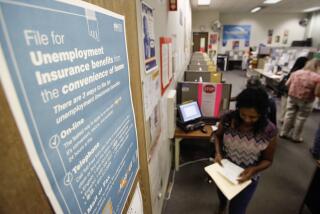May Housing Starts Sink to 5-Month Low
- Share via
WASHINGTON — Builders, concerned that rising mortgage rates will choke off sales, trimmed new home and apartment construction in May to the lowest level in five months.
Stocks and bonds initially rose after the Commerce Department reported that housing starts fell 4.7%, to a seasonally adjusted 1.43-million annual rate, erasing the 4.6% gain in April. However, the market closed lower, with the Dow Jones industrial average down 24.75 points at 5,628.03. Bond prices had also retreated by late in the day.
Regionally, starts rose 0.9% in the South, to a 659,000 rate. But they fell elsewhere--down 13.7% in the West, to a 339,000 rate; down 8.8% in the Northeast, to 124,000; and down 3.4% in the Midwest, to 312,000.
Analysts said the weaker-than-expected report suggests a moderating economy and helped to ease fears that the Federal Reserve Board will boost interest rates next month to slow growth and cool any inflationary pressures.
“The Fed obviously is looking at this number,” said economist David Lereah of the Mortgage Bankers Assn. “This gives them cause to pause. A hike at their July 2-3 meeting is unlikely now.”
Analysts noted that 30-year fixed-rate mortgages topped 8% in May, more than a percentage point above the January average. The increase means a $70 hike in the monthly payment on a $100,000 mortgage.
“Builders are saying . . . there is some impact out there,” said David F. Seiders, an economist with the National Assn. of Home Builders. “When they feel that way, when inventory levels are as high as they are, they cut back on starts.”
New construction decelerated in May to the slowest pace since an equal 1.434-million rate in December. As a result, Seiders said, April’s 1.505-million rate “probably was the high point for the year.”
Meanwhile, the Labor Department said in a separate report Tuesday that workplace productivity shot up 2.1% at an annual rate in the first quarter to the highest level in more than two years.
Productivity, or output per number of hours worked, is a key to the American standard of living. Greater efficiency means businesses can increase wages without raising prices since workers are producing more with the same amount of people.
The report contained little sign of inflation. It said unit labor costs, typically two-thirds of the price of a product, slowed to a 1.2% increase from 3.7% in the previous three months.
But it also showed that so far, many businesses are not increasing worker pay. Compensation rose just 0.1% at an annual rate from January through March, adjusted for inflation.
The Commerce Department report does not offer any hope for a housing start rebound in June. It says applications for building permits, often a barometer of future activity, dropped 1.9% in May to a 1.43-million rate. It was the first decline in four months.
Still, while many analysts expect starts to fall from recent peaks, they predict new construction will remain above the 1.35-million pace of last year. For the first five months of the year, starts were 13.5% above those of the same period in 1995.
Construction of single-family homes, about 80% of total starts, fell 5.9% to a 1.13-million rate, the lowest since November’s equal pace. The drop was the largest since a 12% decline in January 1995.
(BEGIN TEXT OF INFOBOX / INFOGRAPHIC)
Housing Starts
Seasonally adjusted annual rate, in millions of units: (please see newspaper for full chart information)
1996: 1.43
Source: Commerce Department
(BEGIN TEXT OF INFOBOX / INFOGRAPHIC)
Productivity
Percentage change from previous quarter at annual rate, seasonally adjusted:
1996: 2.1%
Source: Labor Department
More to Read
Inside the business of entertainment
The Wide Shot brings you news, analysis and insights on everything from streaming wars to production — and what it all means for the future.
You may occasionally receive promotional content from the Los Angeles Times.










